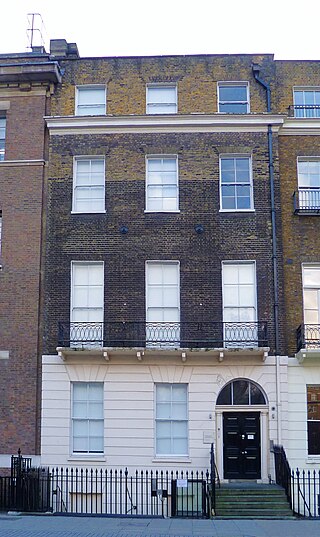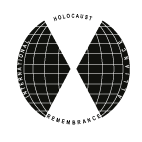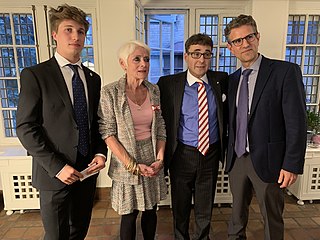Related Research Articles
The Convention on the Prevention and Punishment of the Crime of Genocide (CPPCG), or the Genocide Convention, is an international treaty that criminalizes genocide and obligates state parties to pursue the enforcement of its prohibition. It was the first legal instrument to codify genocide as a crime, and the first human rights treaty unanimously adopted by the United Nations General Assembly, on 9 December 1948, during the third session of the United Nations General Assembly. The Convention entered into force on 12 January 1951 and has 152 state parties as of 2022.
A United Nations General Assembly resolution is a decision or declaration voted on by all member states of the United Nations in the General Assembly.

The United States Holocaust Memorial Museum (USHMM) is the United States' official memorial to the Holocaust. Adjacent to the National Mall in Washington, D.C., the USHMM provides for the documentation, study, and interpretation of Holocaust history. It is dedicated to helping leaders and citizens of the world confront hatred, prevent genocide, promote human dignity, and strengthen democracy.

Holocaust Memorial Day is a national commemoration day in the United Kingdom dedicated to the remembrance of the Jews and others who suffered in the Holocaust, under Nazi persecution. It was first held in January 2001 and has been on the same date every year since. The chosen date is the anniversary of the liberation of Auschwitz concentration camp by the Soviet Union in 1945, the date also chosen for the International Holocaust Remembrance Day and some other national Holocaust Memorial Days.
A Holocaust memorial day or Holocaust remembrance day is an annual observance to commemorate the victims of the Holocaust, the genocide of six million Jews and of millions of other Holocaust victims by Nazi Germany and its collaborators. Many countries, primarily in Europe, have designated national dates of commemoration. In 2005, the United Nations instituted an international observance, International Holocaust Remembrance Day.

The United Nations Office for Outer Space Affairs (UNOOSA) is an office of the U.N. Secretariat that promotes and facilitates peaceful international cooperation in outer space. It works to establish or strengthen the legal and regulatory frameworks for space activities, and assists developing countries in using space science and technology for sustainable socioeconomic development. Another purpose of UNOOSA is to keep affairs proper should the world encounter an alien race in outer space, hence the name.

The Austrian Service Abroad is a non-profit organization founded by Andreas Hörtnagl, Andreas Maislinger and Michael Prochazka in 1998, which sends young Austrians to work in partner institutions worldwide serving Holocaust commemoration in form of the Gedenkdienst, supporting vulnerable social groups and sustainability initiatives in form of the Austrian Social Service and realizing projects of peace within the framework of the Austrian Peace Service. Its services aim at the permanence of life on earth. The Austrian Service Abroad carries and promotes the idea of the House of Responsibility for the birthplace of Adolf Hitler in Braunau am Inn. The Austrian Service Abroad is the issuer of the annually conferred Austrian Holocaust Memorial Award. The program is funded by the Austrian government.

The Montreal Holocaust Museum is a museum located in Montreal, Quebec, Canada, that is dedicated to educating people of all ages and backgrounds about the Holocaust, while sensitizing the public to the universal perils of antisemitism, racism, hate and indifference. Through the museum, its commemorative programs and educational initiatives, it aims to promote respect for diversity and the sanctity of human life. The Museum was founded in 1979 as the Montreal Holocaust Memorial Centre and is Canada's first and only recognized Holocaust museum.

The Wiener Holocaust Library is the world's oldest institution devoted to the study of the Holocaust, its causes and legacies. Founded in 1933 as an information bureau that informed Jewish communities and governments worldwide about the persecution of the Jews under the Nazis, it was transformed into a research institute and public access library after the end of World War II and is situated in Russell Square, London.

The International Holocaust Remembrance Day, or the International Day in Memory of the Victims of the Holocaust, is an international memorial day on 27 January that commemorates the victims of the Holocaust, which resulted in the murder of one third of the Jewish people, along with countless members of other minorities between 1933 and 1945 by Nazi Germany, an attempt to implement their "final solution" to the Jewish question. 27 January was chosen to commemorate the date when the Auschwitz concentration camp was liberated by the Red Army in 1945.

The March of Remembrance and Hope (MRH) is a program designed for university and college students of all religions and backgrounds. The program takes place in mid-May, and includes a two-day trip to Germany, followed by a five-day visit to Poland. The international MRH program was founded in 2001 by Dr. David Machlis of the United States and Eli Rubenstein of Canada, both of whom were involved in the March of the Living (MOL) program.

The International Holocaust Remembrance Alliance (IHRA) is an intergovernmental organization founded in 1998 which unites governments and experts to strengthen, advance and promote Holocaust education, research and remembrance worldwide and to uphold the commitments of the Declaration of the Stockholm International Forum on the Holocaust. The IHRA has 34 member countries, one liaison country and seven observer countries.

The Days of Remembrance of the Victims of the Holocaust (DRVH) is an annual eight-day period designated by the United States Congress for civic commemorations and special educational programs that help citizens remember and draw lessons from the Holocaust. The annual DRVH period normally begins on the Sunday before the Israeli observance of Yom HaShoah, Holocaust Memorial Day, and continues through the following Sunday, usually in April or May. A National Civic Commemoration is held in Washington, D.C., with state, city, and local ceremonies and programs held in most of the fifty states, and on U.S. military ships and stations around the world. The United States Holocaust Memorial Museum designates a theme for each year's programs, and provides materials to help support remembrance efforts.
An atrocity crime is a violation of international criminal law that falls under the historically three legally defined international crimes of genocide, war crimes, and crimes against humanity. Ethnic cleansing is widely regarded as a fourth mass atrocity crime by legal scholars and international non-governmental organizations (NGOs) working in the field, despite not yet being recognized as an independent crime under international law.
The Cape Town Holocaust & Genocide Centre began as Africa's first Holocaust centre founded in 1999. The Centre works towards creating a more caring and just society in which human rights and diversity are respected and valued. Through exhibitions, events and workshops, they endeavour to commemorate the victims and survivors of the Nazi regime and the numerous genocides that happened before and since the Holocaust.
The Cohen Center for Holocaust and Genocide Studies is one of the oldest Holocaust resource centers in the United States. Founded in 1983, the center is located at Keene State College in New Hampshire. The center was founded by Dr. Charles Hildebrandt.
A timeline of the Holocaust is detailed in the events listed below. Also referred to as the Shoah, the Holocaust was a genocide in which some six million European Jews were killed by Nazi Germany and its World War II collaborators. About 1.5 million of the victims were children. Two-thirds of the nine million Jews who had resided in Europe were murdered. The following timeline has been compiled from a variety of sources including the United States Holocaust Memorial Museum.
Genocide education refers to education about patterns and trends in the phenomenon of genocide and/or about the causes, nature and impact of particular instances of genocide.
Daniel Blatman is an Israeli historian, specializing in history of the Holocaust. Blatman is the head of the Institute for Contemporary Jewry at the Hebrew University of Jerusalem.

Naomi Kramer is a Canadian curator and president of the Holocaust Education and Genocide Prevention Foundation.
References
- ↑ 60/7 Resolution http://www.un.org/en/holocaustremembrance/docs/res607.shtml
- ↑ "Women and the Holocaust: Courage and Compassion" http://www.un.org/en/holocaustremembrance/educational_women_and_Holocaust.shtml
- ↑ The Footprints for Hope initiative http://www.un.org/en/holocaustremembrance/educational_footprints.shtml
- ↑ First panel discussion http://webcast.un.org/ramgen/specialevents/se060512holocaust.rm?start=%2200:11:11%22
- ↑ USHMM http://www.ushmm.org/
- ↑ Yad Vashem http://www.yadvashem.org.il/
- ↑ Levande Historia http://www.levandehistoria.se/
- ↑ . The OSCE Website http://www.osce.org/odihr/
- ↑ 2006 Archived video "Archived copy". Archived from the original on 2011-09-27. Retrieved 2011-06-24.
{{cite web}}: CS1 maint: archived copy as title (link) - ↑ 2007 Archived video "Archived copy". Archived from the original on 2011-09-27. Retrieved 2011-06-24.
{{cite web}}: CS1 maint: archived copy as title (link) - ↑ 2008 June Archived video "Archived copy". Archived from the original on 2011-09-27. Retrieved 2011-06-24.
{{cite web}}: CS1 maint: archived copy as title (link) - ↑ 2008 November Archived Video "Archived copy". Archived from the original on 2011-09-27. Retrieved 2011-06-24.
{{cite web}}: CS1 maint: archived copy as title (link) - ↑ Press Release http://www.un.org/News/Press/docs/2009/note6230.doc.htm
- ↑ 2011 Archived Video http://www.un.org/en/holocaustremembrance/20%20Maywebcast.shtml
- ↑ United Nations Information Centres http://unic.un.org/
- ↑ The Holocaust Education Development Programme of University of London http://www.hedp.org.uk/secure/user_create.asp
- ↑ The United Kingdom Holocaust Centre http://holocaustcentre.net/
- ↑ The Anne Frank Center USA http://www.annefrank.com/
- ↑ Press Release:United Nations to Mark Liberation of Bergen-Belsen Concentration Camp with Film at Headquarters http://www.un.org/News/Press/docs/2011/note6304.doc.htm
- ↑ Remarks by Ms. Bonnie Gurewitsch- A Living Memorial to the Holocaust, NYC http://www.un.org/en/holocaustremembrance/2011/Remarks%20Bonnie%20Gurewitsch.shtml